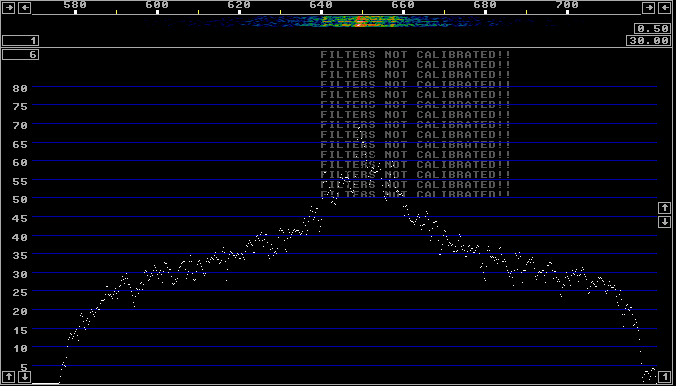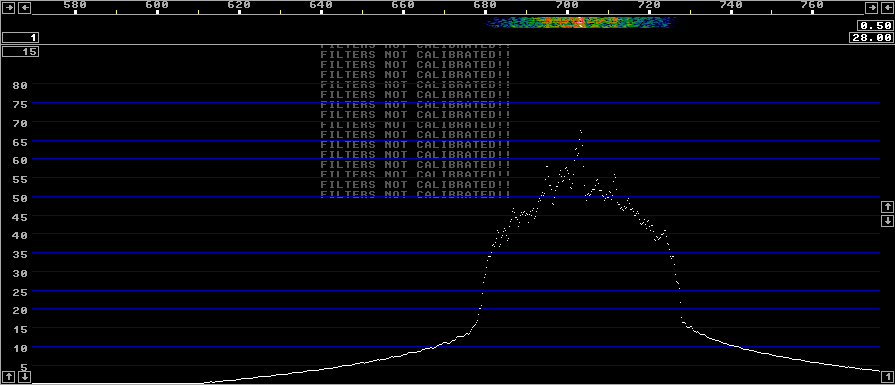
|
The file presented on this page is weakccs144m2rotor.wav
(23961644 bytes.)
The recording was made by Roger, W3SZ.
The zipped file can be downloaded here:
weakccs144m2rotor.zip (11256163 bytes)
This is how Roger describes the file: The signal consists of a 144 MHz beacon made weak by putting it in the null of my eme array and also coing to cross polarization. I then hit it with nearly constant pulse noise. The pulse noise would degrade S/N by about 6 dB if the CW signal were received in a narrow bandwidth without any noise blanker. This data file has been processed by Alberto, I2PHD using Winrad 0.90. Here is the loudspeaker output from Winrad 0.90 with the filter settings that Alberto finds optimal winradweakccs144m2rotorcwpknbnr50_I2PHD.mp3 The output from Winrad can be analyzed with Linrad. With a bin bandwidth of about 1 Hz the screen looks like this. |

|
|
In order to process the weakccs144m2rotor.wav
file with Linrad one has to place the calibration files
dsp_wcw_corr
and dsp_wcw_iqcorr
in the directory from which Linrad is executed.
When a filter with similar characteristics as the one preferred by
Alberto is selected in Linrad, the output sounds like this
ccx_linrad.mp3
and when the loudspeaker output from Linrad is again processed
by Linrad using the same parameters as used for the Winrad
output the screen looks like this:
|

|
|
Alberto and I happened to place our BFOs at opposite sides of
the passband, but otherways Winrad and Linrad produce very similar
outputs as can be seen from the magnified waterfall graphs below
The upper one, from Linrad is flipped horizontally to correct for
the BFO position.
|


|
|
The zero point of the colour scale in the output from Linrad
is about 1 dB lower as compared to Winrad.
The shape factor of the filters are quite different,
but in a background of white noise it does not matter much.
The impulse noise present in the original data is removed
similarly by both programs.
Personally I prefer to use narrower filters. This file, linrad_optccx.mp3 (137088 bytes) is the Linrad-02.03 output with a filter bandwidth of about 25Hz. At such narrow bandwidths I prefer to use some dynamic range expansion. Here the exp parameter of Linrad is set to 1. The Linrad screen lokes like this when processing the raw data file: |

|
|
In order to use Linrad under Linux to process the raw data file weakccs144m2rotor.wav and produce the same result as shown on this page, download linpar.tar (10240 bytes). The file contains a single line adwav which can be used as is or included as one more line in your old adwav if you already have one. Place the raw data file as /wavlib/weakccs144m2rotor.wav and place the parameter files as /wavlib/par/ccx, /wavlib/par/ccx_ag, ........... in accordance with the adwav line. You also have to place the calibration files dsp_wcw_corr and dsp_wcw_iqcorr in the directory from which Linrad is executed. To do the same under Windows, download winpar.zip (2257 bytes). Place adwav in the directory where you have the Linrad executable (linrad.exe) and the calibration files dsp_wcw_corr and dsp_wcw_iqcorr or add the single line of adwav into your old adwav file if you have one. Place the raw data file as C:\wavlib\weakccs144m2rotor.wav and place the parameter files as C:\wavlib\par\ccx, C:\wavlib\par\ccx_ag, ........... in accordance with the adwav line. |